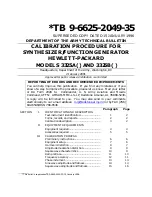
Glossary
If you're relatively new to electronic music, you might be confused by some of the jargon you run across in
the literature you read (such as this manual). The following is a very brief glossary of some terms that are
unique to this field.
Aftertouch
Aftertouch response refers to the capability to vary the sound of a note after the
note has been struck on the keyboard. This is normally accomplished by varying
finger pressure on the key. Depending on the synthesizer, aftertouch can be
used to bend the pitch of a note, apply modulation, or apply just about any other
effect. In the SY35 aftertouch can be assigned to pitch bend, level control, pitch
modulation, or amplitude modulation.
AWM Synthesis
AWM stands for "Advanced Wave Memory," Yamaha's sophisticated sam-
pling technology that allows high-fidelity reproduction of digitally recorded "live"
sound.
Cent
Just as a cent coin is one-hundredth of a dollar, a cent in musical lingo is one-
hundredth of a semitone. The cent is a useful unit when dealing with very small
changes in pitch — such as in synthesizer tuning or detuning functions.
Element
Normally the word "element" refers to a part of something larger. The same
applies in synthesizers. In Yamaha synthesizers, an element is an individually
controllable part of a voice. In the SY35, each voice can have two or four ele-
ments. Each element is actually an independent waveform, so you could have a
4-element voice that is made up of a piano element, a brass element, a strings
element, and a wind element.
Envelope
You'll hear the terms "envelope" and "envelope generator" quite a lot in syn-
thesizer talk. Like the envelope that encloses a letter, a synthesizer envelope
"encloses" the sound, mainly in one of two ways. An amplitude envelope
determines the overall "shape" of the sound — i.e. the speed and shape of the
attack, how fast the sound decays, etc. A pitch envelope determines how the
pitch of a note changes over time- Next to the basic waveform, the amplitude and
pitch envelopes are the most important factors in determining how a voice
sounds.
FM Synthesis
FM is Yamaha's proven Frequency Modulation synthesis technology which is
capable of creating extraordinarily warm, vibrant simulations of actual instru-
ments, as well as an infinite variety of original sounds. The reason for the "FM"
name is that this tone generator system employs a number of independent
oscillator blocks known as "operators," that are arranged in a variety of configu-
rations known as "algorithms." Depending on their positions in the algorithm,
each operator functions either as a "modulator," or a "carrier" that is modulated
by a modulator. Since modulators modulate the frequency of carriers, the system
is a form of frequency modulation — therefore, "FM Synthesis."
41
Summary of Contents for SY-35
Page 1: ...AUTHORIZED PRODUCT MANUAL MUSIC SYNTHESIZER YAMAHA...
Page 2: ...YAMAHA MUSIC SYNTHESIZER...
Page 5: ......
Page 6: ...2...
Page 50: ...YAMAHA WAVEFORM LIST AWM WAVEFORM LIST FM WAVEFORM LIST...
Page 51: ...YAMAHA EDIT REFERENCE...
Page 52: ...YAMAHA MUSIC SYNTHESIZER...
Page 57: ...1...
Page 58: ...2...
Page 80: ...ELEMENT TONE 24...
Page 88: ...ELEMENT ENVELOPE 32...
Page 102: ...UTILITY SETUP 46...
Page 106: ...UTILITY RECALL 50...
Page 113: ...APPENDIX 57...
Page 114: ...APPENDIX 58...
Page 134: ...YAMAHA VN38770 JCAIR2CMS3 3 ITP...
















































